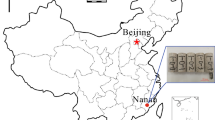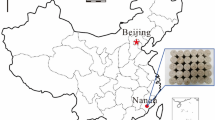Abstract
Naturally cooled granite specimens pretreated at 800 °C were separately subjected to conventional triaxial compression tests and triaxial confining pressure unloading tests under a constant deviatoric stress. Via these tests, the deformation characteristics of granite at different confining pressure unloading rates were explored. The research results showed that the granite specimens were more easily damaged at an intermediate unloading rate than at a high or low unloading rate. The strain–confining pressure compliance results quantitatively revealed that rock failure during unloading was caused by intense radial deformation and volumetric dilatancy. With the increase in the unloading rate, the strain–confining pressure compliance first increased and then decreased. In the confining pressure unloading process, initially, the elastic modulus of the rocks linearly decreased with the decreasing confining pressure. In the case that the confining pressure was unloaded to the critical point where rock failure occurred, the elastic modulus of the rocks dramatically decreased. Additionally, Poisson’s ratio gradually decreased with the reduction in confining pressure. However, approaching the critical point where rock failure occurred during unloading, Poisson’s ratio remarkably decreased. Afterwards, Poisson’s ratio increased to 0.5 and then remained unchanged until the specimens became damaged.










Similar content being viewed by others
References
Aversa S, Evangelista A (1998) The mechanical behaviour of a pyroclastic rock: yield strength and “destructuration” effects. Rock Mech Rock Eng 31(1):25–42
Cai YY, Luo CH, Yu J, Zhang LM (2015) Experimental study on mechanical properties of thermal-damage granite rock under triaxial unloading confining pressure. Chin J Geotech Eng 37(7):1173–1180
Chaki S, Takarli M, Agbodjan WP (2008) Influence of thermal damage on physical properties of a granite rock: porosity, permeability and ultrasonic wave evolutions. Constr Build Mater 22(7):1456–1461
Chen YL, Ni J, Shao W, Azzam R (2012) Experimental study on the influence of temperature on the mechanical properties of granite under uni-axial compression and fatigue loading. Int J Rock Mech Min 56:62–66
Chen X, Tang CA, Yu J, Zhou JF, Cai YY (2018) Experimental investigation on deformation characteristics and permeability evolution of rock under confining pressure unloading conditions. J Central South Univ 25(8):1987–2001
Deng HF, Wang Z, Li JL, Jiang Q, Zhang HB (2017) Effect of unloading rate and pore water pressure on mechanical properties of sandstone. Chin J Geotech Eng 39(11):1976–1983
Du SJ, Liu H, Zhi HT, Chen HH (2004) Testing study on mechanical properties of post-high- temperature granite. Chin J Rock Mech Eng 23(14):2359–2364
Fang XY, Xu JY, Liu S, Wang P (2016) Research on splitting-tensile tests and thermal damage of granite under post-high temperature. Chin J Rock Mech Eng 35(S1):2687–2694
Feng ZJ, Zhao YS, Zhou AC, Zhang N (2012) Development program of hot dry rock geothermal resource in the Yangbajing Basin of China. Renew Energy 39(1):490–495
Hashemi SS, Melkoumian N, Taheri A (2015) A borehole stability study by newly designed laboratory tests on thick-walled hollow cylinders. J Rock Mech Geotech Eng 7(5):519–531
Heueckel T, Peano A, Pellegrini R (1994) A constitute law for thermo-plastic behavior of rocks:an analogy with clays. Surv Geophys 15(5):643–671
Huang RQ, Huang D (2010) Experimental research on affection laws of unloading rates on mechanical properties of Jinping marble under high geostress. Chin J Rock Mech Eng 29(1):21–33
Li JL, Chen X, Dang L, Dong YH, Cheng Z, Guo J (2011) Triaxial unloading test of sandstone after high temperature. Chin J Rock Mech Eng 30(8):1587–1595
Li XB, Cao WZ, Zhou ZL, Zhou Y (2014) Influence of stress path on excavation unloading response. Tunnel Undergr Space Technol 42:237–246
Li JP, Gao L, Mu HS (2019) Dilatancy characteristics of sandstone and its function of dilatancy angle under high confining pressure and unloading conditions. Rock Soil Mech 40(6):2119–2126
Liu S, Xu JY (2014) Mechanical properties of Qinling biotite granite after high temperature treatment. Int J Rock Mech Min 71:188–193
Lönnqvist M, Hökmark H (2016) Thermal, mechanical and thermo-mechanical assessment of the rock mass surrounding SKB’s prototype repository at Äspö HRL. Rock Mech Rock Eng 49(4):1123–1142
Lu YH, Liu QS, Hu YH (2009) Damage deformation characteristics and its strength criterion based on unloading experiments of granites. Chin J Rock Mech Eng 28(10):2096–2103
Nguyen NB, Giraud A, Grgic D (2011) A composite sphere assemblage model for porous oolitic rocks. Int J Rock Mech Min 48(6):909–921
Peng K, Zhou JQ, Zou QL, Zhang J, Wu F (2019a) Effects of stress lower limit during cyclic loading and unloading on deformation characteristics of sandstones. Constr Build Mater 217:202–215
Peng K, Liu ZP, Zhou QL, Zhang ZY, Zhou JQ (2019) Static and dynamic mechanical properties of granite from various burial depths. Rock Mech Rock Eng 1–22
Popov Y, Beardsmore G, Clauser C, Roy S (2016) ISRM suggested methods for determining thermal properties of rocks from laboratory tests at atmospheric pressure. Rock Mech Rock Eng 49(10):4179–4207
Qiu SL, Feng XT, Zhang CZ, Zhou H, Sun F (2010) Experimental research on mechanical properties of deep-buried marble under different unloading rates of confining pressures. Chin J Rock Mech Eng 29(9):1807–1817
Qiu SL, Feng XT, Zhang CZ, Yang JB (2012) Experimental research on mechanical properties of deep marble under different initial damage levels and unloading paths. Chin J. Rock Mech Eng 31(8):1686–1697
Vázquez P, Shushakova V, Gómez-Heras M (2015) Influence of mineralogy on granite decay induced by temperature increase: experimental observations and stress simulation. Eng Geol 189:58–67
Wong TF (1982) Effects of temperature and pressure on failure and post-failure behavior of westerley grinate. Mech Mater 1(1):3–17
Wu G, Zhang L (2004) Studying unloading failure characteristics of a rock mass using disturbed state concept. Int J Rock Mech Min 41(S1):181–187
Xie HQ, He CH (2004) Study of the unloading characteristics of a rock mass using the triaxial test and damage mechanics. Int J Rock Mech Min 41:74–80
Xu XL, Gao F, Zhang ZZ (2014) Research on triaxial compression test of granite after high temperatures. Rock Soil Mech 35(11):3177–3183
Yao MD, Rong G, Zhou CB, Peng J (2016) Effects of thermal damage and confining pressure on the mechanical properties of coarse marble. Rock Mech Rock Eng 49(6):2043–2054
Yin TB, Shu RH, Li XB, Wang P, Liu XL (2016) Comparison of mechanical properties in high temperature and thermal treatment granite. Trans Nonferrous Metal Soc 26(7):1926–1937
Yu QL, Ranjith PG, Liu HY, Yang TH, Tang SB, Tang CA, Yang SQ (2015) A mesostructure-based damage model for thermal cracking analysis and application in granite at elevated temperatures. Rock Mech Rock Eng 48(6):2263–2282
Zhang WQ, Sun Q, Hao SQ, Geng JS, Lv C (2016) Experimental study on the variation of physical and mechanical properties of rock after high temperature treatment. Appl Therm Eng 98:1297–1304
Zhang F, Zhao JJ, Hu DW, Skoczylas F, Shao JF (2018) Laboratory investigation on physical and mechanical properties of granite after heating and water-cooling treatment. Rock Mech Rock Eng 51(3):677–694
Zhu ZN, Tian H, Dong NN, Dou B, Chen J, Zhang Y, Wang BH (2018) Experimental study of physico- mechanical properties of heat-treated granite by water cooling. Rock Soil Mech 39(S2):169–176
Acknowledgements
This work was funded by the State Key Research Development Program of China (2017YFC0804206), National Natural Science Foundation of China (51974043, 51704046, and 51774058), the Chongqing Basic Research and Frontier Exploration Project (cstc2018jcyjA3320), and the Research Fund of the State Key Laboratory of Coal Resources and Safe Mining, CUMT (SKLCRSM18KF025), which are gratefully acknowledged. The authors also thank the editor and anonymous reviewers for their valuable advice.
Author information
Authors and Affiliations
Corresponding authors
Ethics declarations
Data availability statement
Some or all of the data, models, or code generated or used during the study are available from the corresponding author by request.
Additional information
Publisher's Note
Springer Nature remains neutral with regard to jurisdictional claims in published maps and institutional affiliations.
Rights and permissions
About this article
Cite this article
Kang, P., Jing, Z., Quanle, Z. et al. Deformation characteristics of granites at different unloading rates after high-temperature treatment. Environ Earth Sci 79, 343 (2020). https://doi.org/10.1007/s12665-020-09088-y
Received:
Accepted:
Published:
DOI: https://doi.org/10.1007/s12665-020-09088-y




